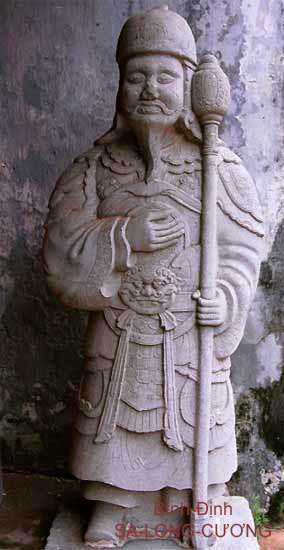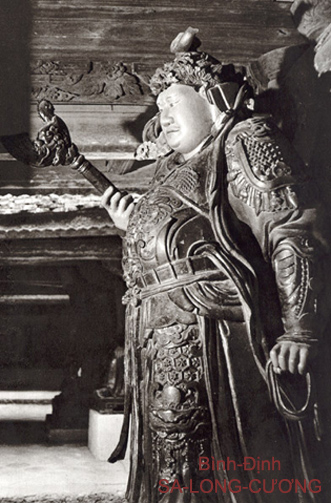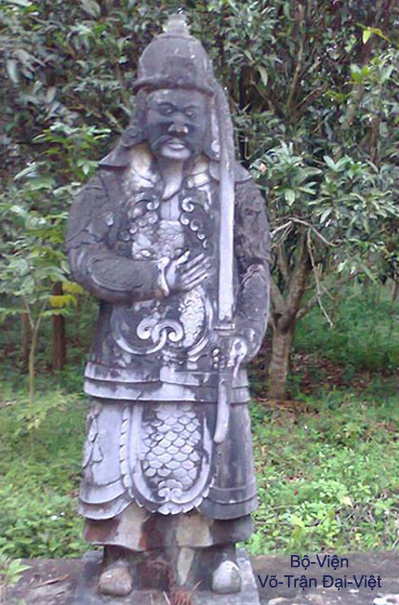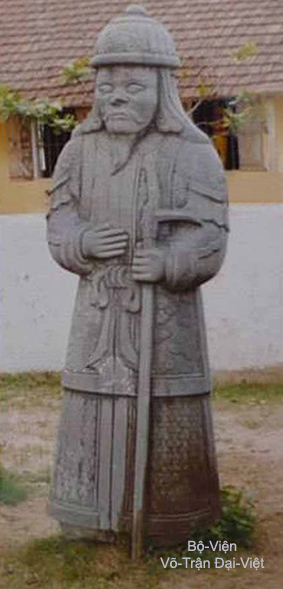II.
THE MEDIEVAL WEAPONS
THE EIGHTEEN MARTIAL ARTS SECTIONS
The expression « Eighteen Sections of Martial Arts » existed since the Middle-Age and included the Medieval Weapons wielding.
In the Song period ( 960 - 1279 ), the expression « Eighteen Sections of Martial Career » was quoted in « Prime Litterary Doctor Trương-Hiệp » (張 協 狀 元).
But it was in the Ming period (1368 - 1644) that we seen Tạ-Triệu-Chiết (藉 肇 浙) enumerating from « The Tray of Great Various Facts - Ngũ Tạp Trở » (五 雜 俎) the Eighteen categories of weapons which were :
01 - Bow ;
02 - Crossbow ;
03 - Spear ;
04 - Vouge of Cavalry (Great Breach Knife holding a dorsal Hook) ;
05 - Sword ;
06 - Pertuisane with Snake Tail-Shaped Blade Spear holding a lateral Hook ;
07 - Shield ;
08 - Battle Axe ;
09 - Battle Pole-Axe with a Blade of Spear ;
10 - Halberd with Two Crescent Moon Side Blades ;
11 - War Whip ;
12 - Blade-Breaker ;
13 - Great War Mace under the form of a hand holding a steel sharp point brush ;
14 - Pike ;
15 - Hooked Spear ;
16 - Battle Staff Drill ;
17 - Silk Rope Activating an Articulated Metal Hand with Claws ;
18 - Bare Hands.
At the time of Qing Dynasty (1644-1912), Chử-Nhân-Hoạch (渚 人 矱) had entered also about Eighteen Sections of Martial Arts in « The Book of Common Use - Kiên Hồ Tập » (肩 乎 集).
According to Grand-Master Trương-Thanh-Đăng, the Đại-Việt « Eighteen Sections of Martial Martial Career » include :
01 - Bow, Pellet Bow and Crossbow ;
02 - Vouge of Cavalry (Great Breach Knife holding a dorsal Hook) ;
03 - Sabre and Scimitar ;
04 - Spear with Straight Blade, Spear with Bent Blade, Spear with Straight Blade holding a Hook (Korseke) ;
05 - Sword (Unique Sword & Two Matched Swords) ;
06 - Pertuisane with Snake-shaped Blade ;
07 - Shield ;
08 - Two Matched Battle Axes ;
09 - Great Battle-Axe with a Spear Blade ;
10 - Halberd with Two Crescent Moon Side Blades ;
11 - Long War Pole and Short War Pole ;
12 - Blade-Breaker and Two Matched Blade-Breakers ;
13 - Great War Mace and Two Matched War Maces ;
14 - Trident ;
15 - Short Battle Staff Drill, Medium Battle Staff Drill coming up to Eyebrows and Long Battle Staff Drill ;
16 - War Rake ;
17 - Rope ;
18 - Bare Hands.
Statue of Đại-Việt Warrior with Armour |
Statue of Dharmapala with Armour
|
Statue of Đại-Việt Warrior in Infantryman Armour
|
Statue of Đại-Việt Warrior in Cavalry Armour
|

under the reign of Nguyễn Dynasty Khải-Định Emperor (1916-1926).
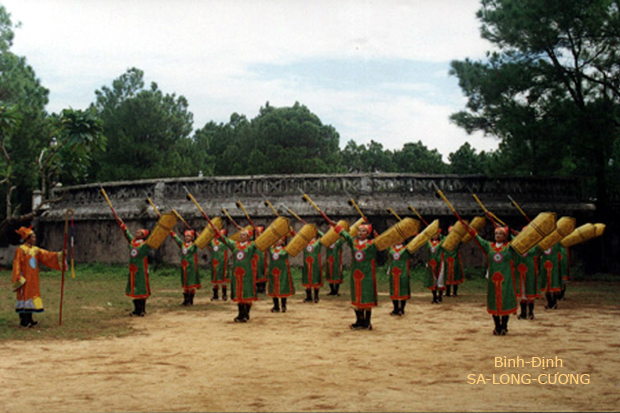
Warrior Dance of Eight Ranks
of Eight Mimes at the old Imperial Capital of Huế
(Photo taken in 2002).
Although chinese peoplekwowsthe wielding of « Two Matched Maces » and the use of « Pellet Bow », he doesn't quote them in his « Eighteen Sections of Martial Arts » because on battle fields, chinese warriors wield only « Unique Mace » and use only « Bow & Crossbow ».
So, «Two Matched Maces» and the «Pellet Bow» exist only in the Đại-Việt «Eighteen Sections of Martial Arts».
The «Pellet Bow» is a shooting weapon that the form comes from the one of the « Bow » ; consequently, it looks like a Bow but it owns two ropes tied to two ends and linked in the middle to a piece of leather, using to throw pebble, stone or lead ball and it's by far more than the « Fronde » of Greecs and Romans. In 19th century, afterwards the rubber was discovered by Charles GOODYEAR (1800-1860), Vietnameses invented « the Birds Hunting Pebble-Thrower - Ná Bắn Chim » that the uprights took the form of the letter " Y ", and that the French did to disclose in Europe. Nowadays, everybody knows well about it.
The « Pellet Bow » was perpetuated in Việt-Nam until the beginning of 20th century, then after which, it was prohibited ; that why among the vietnamese youth today, rare are those who know it.
« Pellet Bow » in usage at Saigon Archery Association, |
« Pellet Bow » in usage at Saigon Archery Association, |
In addition, it exists a certain number of others weapons, depending to the dexterity of Vietnamese Martial Arts Experts who train with which according to their preference. Among those, two particular weapons, invented by Việt people for Battle Fields Martial Arts, are worth to remind here : that is about « Two Matched Armed Arms - Song-Xỉ (双 齒) » and « Spear with a Blade perpendicular to a War hammer, or Hammer-Spear - Thiên-Phủ-Giáo (偏 斧 槊) ».
1) - The « Two Matched Armed Arms - Song-Xỉ (双 齒) » belongs to Đại-Việt "Close-Combat Weapons". It includes two kinds :
a. The « Two Matched Armed Arms holding a sharp hook » (It is under the form of steel gutter, owning a sharp hook and envelopping the two forearms, beyond the elbow untill the wrist ; It uses with a Blade of Axe without handle, called "Axe finding the Lightning" that we hold in each hand - it's the oldest ;
b. The « Two Matched Armed Arms devoid of sharp hook » (It takes the form of steel junk envelopping the two forearms, beyond the elbow untill the fist) - that it's the «Two Matched Armed-Arms - Song-Xỉ» used by combatants of law in the Tây-Sơn Dynasty (1788-1802) period.
2) - The « Hammer-Spear - Thiên-Phủ-Giáo (偏 斧 槊) » belongs to Đại-Việt "Weapons of Shock" . It includes a long pole holding a Blade of Spear linked at right angles to a transversal War Hammer with two round-ended. That is a weapon specialized in the neutralization of adversaries wearing plaited wicker armours (that no scimitar, no spear, no sword, no halleberd can overcome). The «Hammer-Spear - Thiên-Phủ-Giáo» armed Việt warriors since the Đinh period (968-980) and was a common use until the Lý period (1010-1225), Trần period (1225-1413).
Committee of Martial Arts Masters |
Copyright © 2004 - 2018 by ACFDV - All rights reserved.
